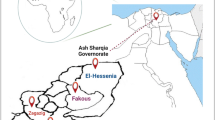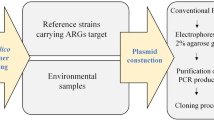Abstract
There is an increasing level of interest in non-tuberculous mycobacteria (NTM) due to the increasing reported rates of diseases caused by them. Although it is well known that NTM are widely distributed in the environment it is necessary to identify its reservoirs to prevent possible infections. In this study, we aimed to investigate the occurrence and levels of NTM in cooling towers to provide evidences for considering these settings as possible sources of respiratory infections. In the current study, we detected and quantified the presence of NTM by means of a rapid method in water samples taken from 53 cooling towers of an urban area (Barcelona, Spain). A genus-specific quantitative PCR (Q-PCR) assay with a quantification limit (QL) of 500 cells l−1 was used. 56% (30) of samples were positive with a concentration range from 4.6 × 103 to 1.79 × 106 cells l−1. In some cases (9/30), samples were positive but with levels below the QL. The colonization rate confirmed that cooling towers could be considered as a potential reservoir for NTM. This study also evaluated Q-PCR as a useful method to detect and quantify NTM in samples coming from environmental sources.
Similar content being viewed by others
References
Angenent LT, Kelley ST, St Amand A et al (2005) Molecular identification of potential pathogens in water and air of a hospital therapy pool. Proc Natl Acad Sci USA 102(13):4860–4865
Altschul SF, Madden TL, Schäffer AA et al (1997) Gapped BLAST and PSI-BLAST: a new generation of protein database search programs. Nucleic Acids Res 25(17):3389–3402. doi:10.1093/nar/25.17.3389
Bartram J, Bentham R, Briand E et al (2007) Legionella and the prevention of legionellosis. In: Approaches to risk management. World Health Organization. ISBN 92 4 156297 8
Black W, Berk SG (2003) Cooling towers—a potential environmental source of slow-growing mycobacterial species. AIHA J 64:238–242
Cook KL, Britt JS (2007) Optimization of methods for detecting Mycobacterium avium subsp. paratuberculosis in environmental samples using quantitative, real-time PCR. J Microbiol Methods 69:154–160
de Groote MA, Huitt G (2006) Infections due to rapidly growing mycobacteria. Clin Infect Dis 42:1756–1763
Ding L, Lai C, Lee L et al (2006) Disease caused by non-tuberculous mycobacteria in a university hospital in Taiwan, 1997–2003. Epidemiol Infect 134:1060–1067
Falkinham JO III (2003) Mycobacterial aerosols and respiratory disease. Emerg Infect Dis 9:763–767
Falkinham JO (2009) Surrounded by mycobacteria: nontuberculous mycobacteria in the human environment. J Appl Microbiol 107:356–367
Field S, Cowie RL (2006) Lung disease due to the more common nontuberculous mycobacteria. Chest 129:1653–1672
Ford T, Hermon-Taylor J, Nichols G (2004) Approaches to risk management in priority setting. In: Bartram J, Cotruvo JA, Dufour A, Rees G, Pedley S et al (eds) Pathogenic mycobacteria in water: a guide to public health consequences. Monitoring and management. World Health Organization, Geneva
Glassroth J (2008) Pulmonary disease due to nontuberculous mycobacteria. Chest 133:243–251
Griffith DE, Aksamit T, Brown-Elliot BA et al (2007) An official ATS/IDSA statement: diagnosis, treatment and prevention of nontuberculous mycobacterial diseases. Am J Respir Crit Care Med 175:367–416
Khan IU, Yadav JS (2004) Real-time PCR for genus-specific detection and quantification of culturable and non-culturable mycobacteria and pseudomonads in metalworking fluids. Mol Cell Probes 18:67–73
Marras TK, Chedore P, Ying et al (2007) Isolation prevalence of pulmonary non-tuberculous mycobacteria in Ontario, 1997–2003. Thorax 62:661–666
Martin-Casabona N, Bahrmand AR, Bennedsen et al (2004) Non-tuberculous mycobacteria: patterns of isolation. A multi-country retrospective survey. Int J Tuberc Lung Dis 8:1186–1193
Nwachcuku N, Gerba CP (2004) Emerging waterborne pathogens: can we kill them all? Curr Opin Biotechnol 15(3):175–180
Pagnier I, Merchat M, La Scola B (2009) Potentially pathogenic amoeba-associated microorganisms in cooling towers and their control. Future Microbiol 4(5):615–629
Pagnier I, Merchat M, Raoult D, La Scola B (2009) Emerging mycobacteria spp. in cooling towers. Emerg Infect Dis 15:121–122
Park H, Jang H, Kim C et al (2000) Detection and identification of mycobacteria by amplification of the internal transcribed spacer regions with genus-and species-specific PCR primers. J Clin Microbiol 38:4080–4085
Parker BC, Ford MA, Grufh H et al (1983) Epidemiology of infection by nontuberculous mycobacteria: IV. Preferential aerosolization of Mycobacterium intracellulare from natural waters. Am Rev Respir Dis 128:652–656
Rasmussen R (2001) Quantification on the LightCycler. In: Witwe C, Nakagawara K, Meuer S (eds) Rapid cycler real-time PCR, methods and applications. Springer, Heidelberg, pp 21–34
Richardson ET, Samson D, Banaei N (2009) Rapid Identification of Mycobacterium tuberculosis and nontuberculous mycobacteria by multiplex, real-time PCR. J Clin Microbiol 47:1497–1502
September SM, Brözel VS, Venter SN (2004) Diversity of nontuberculoid Mycobacterium species in biofilms of urban and semiurban drinking water distribution systems. Appl Environ Microbiol 70:7571–7573
Shelton BG, Flanders WD, Morris GK (1999) Mycobacterium sp. as a possible cause of hypersensitivity pneumonitis in machine workers. Emerg Infect Dis 5:270–273
Skinner MA, Yuan S, Prestidge R et al (1997) Immunization with heat-killed Mycobacterium vaccae stimulates CD8+ cytotoxic T cells specific for macrophages infected with Mycobacterium tuberculosis. Infect Immun 65:4525–4530
Speizer FE (2000) Occupational and environmental lung diseases: an overview. Environ Health Perspect 108(suppl 4):603–604
Torkko P, Suomalainen S, Iivanainen et al (2002) Mycobacterium palustre sp. nov., a potentially pathogenic, slowly growing mycobacterium isolated from clinical and veterinary specimens and from Finnish stream waters. Int J Syst Evol Microbiol 52:1519–1525
Van Ingen J, Boeree MJ, Dekhuijzen PNR, van Soolingen DE (2009) Environmental sources of rapid growing nontuberculous mycobacteria causing disease in humans. Clin Microbiol Infect 15:888–893
Acknowledgements
We thank Dr. Enrico Tortoli (Regional Mycobacteria Reference Centre, Florence, Italy) and Dr. Núria Martin-Casabona (Vall d’Hebrón Hospital, Barcelona, Spain) for providing M. palustre and M. xenopi clinical isolates, respectively. We also thank Dr. Laura Villanueva (NIOZ Royal Netherlands Institute for Sea Research, The Netherlands) for critical revision of the manuscript. This work was supported by the Ministerio de Ciencia e Innovación with grant CTM2005-06457-C05-05/TECNO to JM, PI081062 grant to ET, SAF2006-05868 grant to EJ, and by 2009SGR-00108 grant to EJ and ML. ET and BA were supported by Ramon y Cajal and by FPI program (Ministerio de Ciencia e Innovación), respectively.
Author information
Authors and Affiliations
Corresponding author
Rights and permissions
About this article
Cite this article
Adrados, B., Julián, E., Codony, F. et al. Prevalence and Concentration of Non-tuberculous Mycobacteria in Cooling Towers by Means of Quantitative PCR: A Prospective Study. Curr Microbiol 62, 313–319 (2011). https://doi.org/10.1007/s00284-010-9706-2
Received:
Accepted:
Published:
Issue Date:
DOI: https://doi.org/10.1007/s00284-010-9706-2




